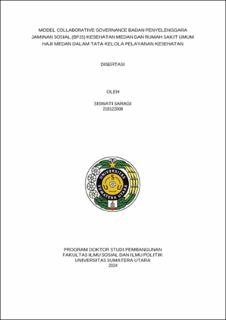Model Collaborative Governance Badan Penyelenggara Jaminan Sosial (BPJS) Kesehatan Medan dan Rumah Sakit Umum Haji Medan dalam Tata Kelola Pelayanan Kesehatan
Collaborative Governance Model of The Social Security Administering Body for Health (BPJS) and The Haji General Hospital of Medan in The Management of Health Services in Medan City

Date
2024Author
Saragi, Siswati
Advisor(s)
Sihombing, Marlon
Kusmanto, Heri
Zulfendri
Metadata
Show full item recordAbstract
Collaboration in health service governance between The Social Security Administering Body for Health (BPJS) Medan and the Medan Haji General Hospital is still not optimal. There are many complaints about services from patients using BPJS health insurance. This is due to poor communication and coordination among the parties involved, so there is a need for a study on Collaborative Governance between BPJS Health Insurance and Haji General Hospita of Medan. This research aims to analyze the governance of the Medan BPJS Health Insurance, the governance of the Medan Haji General Hospital and the collaboration of the Medan Health Social Security Administering Agency (BPJS) and the Medan Haji General Hospital in service governance. This research uses a qualitative method measuring quality using Collaborative Governance theory. From the results of the interviews, it was found that the management of the BPJS Health Insurance and the Management of the Medan Haji General Hospital have been running well. However, there are still problems with lack of resources in carrying out tasks. Collaborative Governance between BPJS Health Insurance and RSU Haji Medan has been going well, but from the aspect of Participation (Communication, Coordination and Supervision), especially in determining claims rules, it has not been running optimally because it has not taken into account the aspirations of paramedics, especially doctors. The collaboration model offered is a cooperation network, involvement in determining claims, establishing coordination and communication as well as supervision involving hospitals in the Fraud team. The obstacles in this model are the costs required, a complicated bureaucratic culture, and insufficient collaboration between institutions involved in policy formulation.
